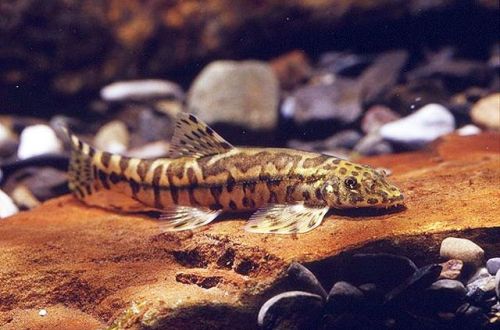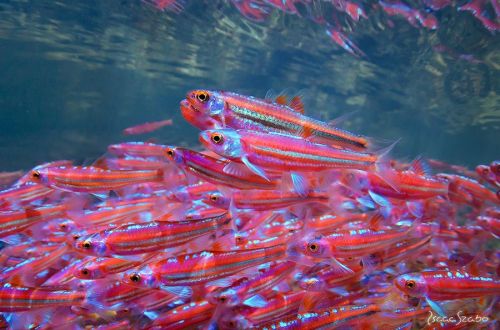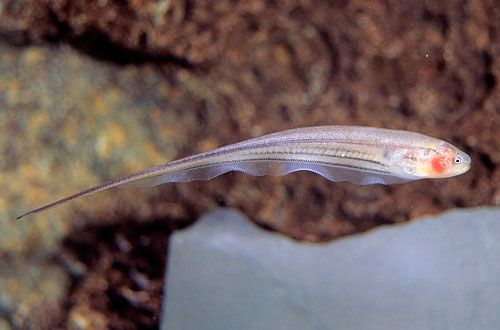
Tassel char
Brush char, scientific name Formosania lacustre, belongs to the family Balitoridae (river char). They got their name because of the structure of the body – long and narrow, but with a large tail, due to which they resemble a distant brush. Quite difficult to keep due to the need to maintain high water quality and strong current conditions. Not recommended for beginner aquarists.

Contents
Habitat
It comes from the territory of the eastern provinces of China (Fujian region) and the island of Taiwan. Inhabits the upper reaches of numerous mountain rivers and streams with fast, sometimes turbulent currents. The fish prefer well-lit shallow water regions with substrates made of stones covered with a film of algae. Aquatic vegetation mainly grows along the banks and less often in the stream bed.
Brief information:
- The volume of the aquarium – from 100 liters.
- Temperature – 20-24°C
- Value pH — 6.0–7.5
- Water hardness – soft (1-12 dGH)
- Substrate type — stony
- Lighting – moderate or bright
- Brackish water – no
- Water movement – moderate or strong
- The size of the fish is 10–12 cm.
- Nutrition – sinking and gel food
- Temperament – peaceful
- Keeping a group of 3–4 individuals
Description
Adult individuals reach a length of 10–12 cm. The tassel char is adapted to life in conditions of a rapid flow of water, which affected its appearance. The body is strongly elongated, the head has a pointed and elongated shape and is equipped with a sucker mouth. Paired fins are oriented horizontally and shifted closer to the abdomen. They help to firmly cling to hard surfaces. They swim poorly, instead they rather “crawl” along the bottom in search of food. The body coloration and pattern is somewhat different in populations from mainland and insular China. The body patterns of fish from the island are more complex, consisting of brown symmetrical pigmentation on a yellowish background and a dark stripe running along the lateral line. In continental representatives of the species, the color is often monophonic, gray.
Food
In nature, the basis of the diet are small crustaceans, insect larvae and other invertebrates. Unlike most other closely related species, algae are not part of their daily diet. In the home aquarium, a high protein diet consisting of live or frozen brine shrimp, daphnia, bloodworms and similar foods is preferred.
During feeding, it is desirable to reduce the operation of the filters, thereby reducing the movement of the flow and preventing the feed from being washed away. Products should be placed in different areas so that the fish do not compete with each other for food. If gel or paste feeds are used, then there is no need to temporarily reduce the performance of the filters.
Maintenance and care, arrangement of the aquarium
The optimal size of the aquarium for a group of 3-4 fish starts from 100 liters, and the tank should not be too high, just 30 cm is enough. indicators. Equally important is the presence of a sufficiently strong current, simulating the rapid flow of a mountain river. The circulation of water should be 10-15 times per hour. A powerful internal overpower filter can handle these tasks. For example, for a volume of water of 100 liters, you need a filter that pumps through itself about 1000 liters in one hour. Maintaining high water quality also depends on the regularity of some essential aquarium maintenance. In particular, this is a weekly replacement of part of the water with fresh and timely removal of organic waste.
The decor is simple. The focus is on the substrate. It is necessary to avoid elements that can be picked up by the flow and they will randomly circulate in the water, clogging the filter, for example, fine sand. The soil should consist of coarse gravel, stones, boulders and various rocks. Live plants are usually not used.
Behavior and Compatibility
They are considered a territorial species, competing with relatives. The main reason for competition is the struggle for food. In a nature with limited resources, fish are very jealous of their territory. In a home aquarium, the problem can be solved by placing food in different places on the bottom. Compatible with other non-aggressive fish that can live in a similar turbulent environment.
Breeding / breeding
At the time of preparation of materials for this article, the authors did not find reliable information about the successful cases of breeding Loach-brush in home aquariums.
Fish diseases
Health problems arise only in case of injuries or when kept in unsuitable conditions, which depresses the immune system and, as a result, provokes the occurrence of any disease. In the event of the appearance of the first symptoms, first of all, it is necessary to check the water for the excess of certain indicators or the presence of dangerous concentrations of toxic substances (nitrites, nitrates, ammonium, etc.). If deviations are found, bring all values back to normal and only then proceed with treatment. Read more about symptoms and treatments in the Aquarium Fish Diseases section.





